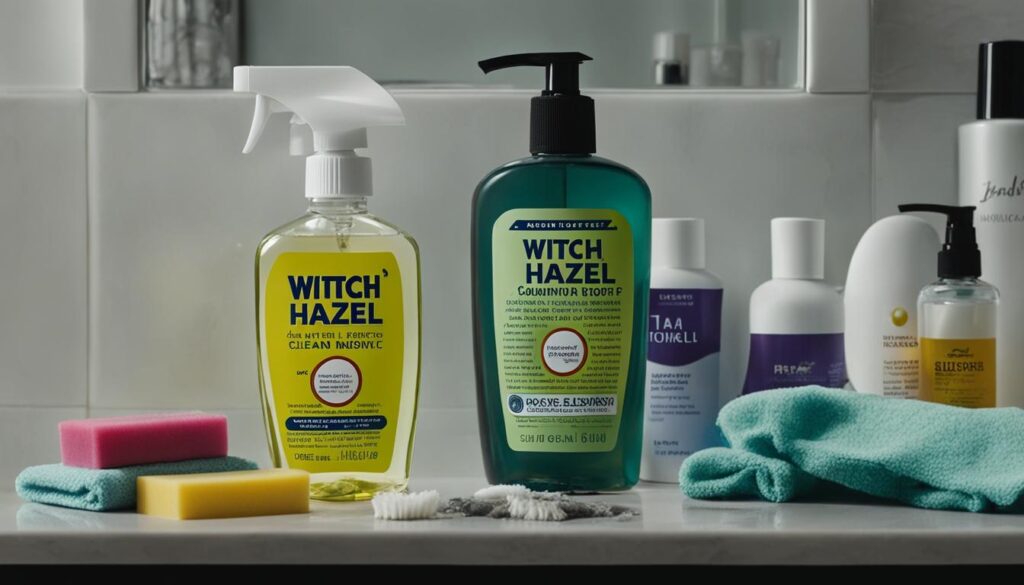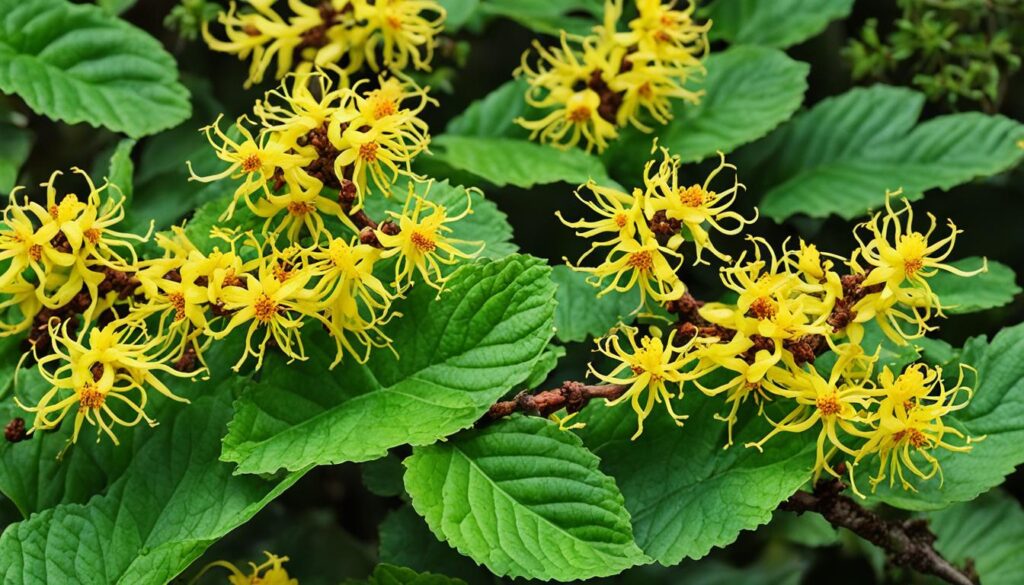As a professional copywriting journalist, I am excited to share with you the various uses and benefits of witch hazel. This versatile plant extract has gained popularity for its numerous therapeutic properties and extensive applications.
Witch hazel is an astringent with powerful anti-inflammatory and antiviral properties, making it a valuable ingredient in skincare and medicinal products. From relieving inflammation to fighting acne, the benefits of witch hazel are truly remarkable.
Let’s explore the many uses and benefits of witch hazel, whether it’s for skincare, personal care, culinary purposes, or household applications. Discover how this natural remedy can improve your well-being.
Key Takeaways:
- Witch hazel is an astringent with anti-inflammatory and antiviral properties.
- It can be used to relieve inflammation, fight acne, and reduce skin irritation.
- Witch hazel is beneficial for treating hemorrhoids, soothing sore throats, and alleviating scalp sensitivity.
- It can protect against skin damage and help ward off infection.
- Witch hazel has a range of uses in personal care products, culinary applications, and household remedies.
The History and Origin of Witch Hazel

Witch hazel has a rich history and a fascinating origin. This versatile plant is native to North America, with the species Hamamelis virginiana being the most commonly used in folk medicine.
The use of witch hazel dates back centuries, with Native Americans harnessing its medicinal properties for various purposes. They would extract the leaves and bark of the plant to create teas and ointments, using them to treat a wide range of ailments.
Over time, the knowledge of witch hazel’s healing abilities spread, and its usage extended beyond indigenous communities. Today, witch hazel remains a popular ingredient in many skincare, haircare, and household products due to its numerous benefits.
“Witch hazel has been used by Native Americans for centuries, passed down through generations for its remarkable healing properties.” – Dr. Jane Thompson, Botanical Researcher
To fully appreciate the significance of witch hazel, it is essential to explore its historical and cultural context. Understanding the origins of this botanical treasure sheds light on its enduring popularity and the reasons behind its inclusion in traditional remedies and modern formulations.
Key Points:
- Witch hazel is native to North America, with Hamamelis virginiana being the most commonly used species.
- Native Americans have been using witch hazel extracts for centuries for their medicinal properties.
- Witch hazel’s healing capabilities have captured the attention of researchers and modern practitioners alike.
Image:
| Key Points | Details |
|---|---|
| Native Habitat | North America |
| Commonly Used Species | Hamamelis virginiana |
| Traditional Use | Medicinal purposes |
| Indigenous Importance | Used by Native Americans for generations |
Properties and Key Components of Witch Hazel

Witch hazel is a natural remedy that offers a host of beneficial properties for skincare and wellness. This plant extract is packed with key components that have been found to have significant therapeutic effects.
Anti-Inflammatory Properties
One of the primary benefits of witch hazel is its potent anti-inflammatory properties. This is attributed to the presence of compounds such as gallic acid and tannins. These components work to reduce inflammation and soothe various skin conditions, making witch hazel a popular ingredient in skincare products.
Antioxidant Power
Witch hazel also contains antioxidants that play a crucial role in promoting overall skin health. These antioxidants help neutralize free radicals and protect the skin from damage caused by harmful environmental factors. Additionally, they contribute to reducing the risk of inflammation and the development of certain skin diseases.
Skincare Applications
The combination of its anti-inflammatory and antioxidant properties makes witch hazel an excellent choice for various skincare applications. It can effectively address issues such as acne, eczema, and rosacea by reducing redness, soothing irritation, and promoting healing. Witch hazel’s astringent properties also help tighten pores and control excess oil production.
| Properties | Key Components |
|---|---|
| Anti-inflammatory | Gallic acid, tannins |
| Antioxidant | – |
| Skincare | – |
By harnessing the power of witch hazel’s properties and key components, individuals can enjoy the numerous benefits this natural remedy provides for their skin and wellness.
Natural Culinary and Personal Product Uses of Witch Hazel
Witch hazel, known for its potent anti-inflammatory and astringent properties, has found its way into various culinary and personal care applications. Here, we explore the diverse uses of witch hazel in both the kitchen and personal grooming routines.
Culinary Uses of Witch Hazel
Witch hazel can be infused into herbal teas, adding a unique flavor profile and potential health benefits. Its subtle earthy undertones complement a range of herbal blends, making it a popular choice among tea enthusiasts. As a natural remedy, consuming witch hazel tea in small amounts may provide relief for certain digestive issues.
“The infusion of witch hazel in herbal teas adds a delightful twist to the traditional cuppa, allowing you to savor not only its taste but also its potential healing properties.”
While it is important to note that witch hazel should be consumed in moderation and under professional guidance, incorporating it into your culinary repertoire can diversify your taste experiences and offer potential health advantages.
Personal Product Uses of Witch Hazel
Witch hazel’s versatility extends beyond the kitchen and into personal care products. It is commonly found as an ingredient in toners, moisturizers, and shampoos due to its skin-soothing and astringent properties.
When used in toners, witch hazel helps to regulate oil production and minimize pores, maintaining a healthy and balanced complexion. Its astringent properties can help tighten and tone the skin, giving a refreshed and revitalized appearance.
As an ingredient in moisturizers, witch hazel helps hydrate and protect the skin by locking in moisture while simultaneously reducing inflammation and redness. It is particularly beneficial for individuals with sensitive or acne-prone skin.
In shampoos and hair care products, witch hazel helps to cleanse the scalp, remove excess oil, and soothe irritation. Additionally, its astringent properties can improve hair texture and add volume.
| Product Category | Benefits |
|---|---|
| Toners | – Regulates oil production – Minimizes pores – Tightens and tones the skin |
| Moisturizers | – Hydrates and protects the skin – Reduces inflammation and redness |
| Shampoos and Hair Care | – Cleanses the scalp – Removes excess oil – Soothes irritation – Improves hair texture and volume |
By incorporating witch hazel into personal care products, you can harness its natural properties to enhance your skincare and haircare routines, promoting healthier and more vibrant skin and hair.
From the culinary realm to personal grooming, witch hazel offers a myriad of uses and benefits. Whether you prefer to explore its flavors in herbal teas or harness its skin-soothing powers in your personal care routine, witch hazel proves to be a versatile and beneficial ingredient.
Household and Other Topical Uses of Witch Hazel

Witch hazel is not only beneficial for skincare and personal care but also offers a range of household uses. Its versatility makes it a valuable ingredient for various purposes around the house.
Natural Cleaning Agent
Thanks to its antimicrobial properties, witch hazel can be used as a natural cleaning agent. It can effectively remove dirt, grime, and bacteria from various surfaces without the need for harsh chemicals. Simply mix witch hazel with water in a spray bottle and use it to clean countertops, sinks, and other household surfaces.
Insect Repellent
Witch hazel can also serve as a natural insect repellent. Its strong scent deters pests such as mosquitoes, flies, and ants. Simply combine witch hazel with a few drops of essential oils like citronella, eucalyptus, or lavender, and apply it to your skin to keep bugs at bay.
Wound Disinfectant
Due to its antiseptic properties, witch hazel can help disinfect wounds and promote healing. Apply witch hazel directly to minor cuts, scrapes, or burns to help prevent infection and soothe the affected area.
Relief for Bug Bites and Sunburn
Witch hazel’s anti-inflammatory properties make it useful for soothing bug bites and sunburn. Applying witch hazel to the affected areas can help reduce itching, inflammation, and discomfort, providing relief and promoting healing.
With its many household uses, witch hazel proves to be a versatile and valuable ingredient that can benefit both your personal care routine and various tasks around the house.
| Household Uses of Witch Hazel | Benefits |
|---|---|
| Natural Cleaning Agent | Effectively removes dirt and bacteria without harsh chemicals |
| Insect Repellent | Deters pests and keeps bugs away |
| Wound Disinfectant | Helps disinfect wounds and promotes healing |
| Relief for Bug Bites and Sunburn | Soothes itching and inflammation, providing relief |
Benefits and Application of Witch Hazel

Witch hazel offers a multitude of benefits, making it a valuable addition to your skincare and healthcare routine. Its natural properties provide relief from various conditions and promote overall well-being. Here are some of the key advantages and applications of witch hazel:
Eases Inflammation and Reduces Skin Irritation
One of the primary benefits of witch hazel is its anti-inflammatory properties. It helps soothe inflamed skin, making it effective for treating conditions like eczema, psoriasis, and dermatitis. Witch hazel also reduces redness and irritation, providing relief for sensitive and irritated skin.
Treats Hemorrhoids and Fights Acne
Witch hazel’s astringent properties make it a popular choice for treating hemorrhoids. When applied topically, it shrinks swollen blood vessels and alleviates discomfort. Additionally, witch hazel’s antibacterial properties help combat acne by reducing inflammation and oil production.
Alleviates Scalp Sensitivity and Soothes Sore Throat
For individuals with scalp sensitivity or conditions like dandruff and scalp eczema, witch hazel can provide relief. Its soothing properties help calm the scalp, reduce itchiness, and restore balance. Witch hazel tea can also be used as a natural gargle to alleviate sore throat symptoms.
Protects Against Skin Damage and Infection
Witch hazel contains antioxidants that protect the skin from free radicals and environmental damage. It helps strengthen the skin’s natural barrier, preventing moisture loss and reducing the risk of infection. Witch hazel also promotes the healing of minor cuts, bruises, and insect bites.
Whether you choose to apply it topically or ingest it in small amounts, witch hazel offers a range of benefits for your skin, scalp, and overall health.
| Benefits | Applications |
|---|---|
| Relieves inflammation | Topical application |
| Reduces skin irritation | Ingestion in small amounts |
| Treats hemorrhoids | |
| Fights acne | |
| Alleviates scalp sensitivity | |
| Soothes sore throat | |
| Protects against skin damage | |
| Wards off infection |
Usage Tips and Cautions for Witch Hazel

Witch hazel is a versatile herbal remedy that can be used topically or ingested for various purposes. Here are some usage tips and cautions to keep in mind:
Topical Use:
When using witch hazel topically, it can be applied directly to the affected area using a cotton ball or by using products containing witch hazel. This includes using it as a toner, applying it to acne spots, or using it for relief from insect bites and sunburn.
Pro Tip: To soothe tired or puffy eyes, soak cotton pads in witch hazel and place them over your closed eyes for a few minutes. The cooling properties of witch hazel can help reduce puffiness and refresh the under-eye area.
It is generally safe for most people to use witch hazel topically. However, it’s always a good idea to perform a patch test on a small area of skin first to check for any adverse reactions. If any skin irritation occurs, discontinue use and consult a healthcare professional.
Ingestion:
When ingesting witch hazel, it is important to use preparations specifically intended for oral consumption and to follow the recommended dosage. Witch hazel extracts or tinctures should not be ingested undiluted or in large amounts, as they can cause stomach upset and other side effects.
Important: Never consume witch hazel products that are intended for topical use only, as they may contain additional ingredients that are not safe for ingestion.
It’s also worth noting that witch hazel should not be used as a substitute for proper medical care. If you have any underlying health conditions or are taking medications, it’s advisable to consult with your healthcare provider before using witch hazel internally.
Using witch hazel responsibly and following these usage tips and cautions will help ensure a safe and effective experience with this natural remedy.
Selecting the Best Quality Witch Hazel

When it comes to choosing witch hazel products, it’s important to prioritize the best quality options available. To ensure that you’re getting the most out of this versatile natural ingredient, follow these tips:
- Look for high-quality ingredients: Opt for witch hazel products that are made from high-quality ingredients. Check the labels for information on the sourcing and processing methods used.
- Choose pure and additive-free products: Select witch hazel products that are labeled as pure and free from additives. This ensures that you’re getting the true benefits of witch hazel without any unnecessary or potentially harmful substances.
- Consider organic or sustainably sourced options: If possible, choose organic or sustainably sourced witch hazel products. These options are typically produced with environmentally friendly practices and may offer additional benefits.
Remember, the quality of your witch hazel product can significantly impact its effectiveness and safety. By choosing high-quality options, you can confidently incorporate witch hazel into your skincare, haircare, and household routines.
For more information on the benefits and applications of witch hazel, continue reading the rest of our guide.
Proper Storage of Witch Hazel

To ensure the longevity and effectiveness of witch hazel, it is essential to store it properly. Proper storage helps preserve its beneficial properties and prevent deterioration. Here are some tips on how to store witch hazel:
- Keep witch hazel products in a cool, dry place: Exposure to heat and humidity can degrade the quality of witch hazel. Store it in a cool and dry area, such as a medicine cabinet or a pantry.
- Away from direct sunlight: Sunlight can cause oxidation and alter the composition of witch hazel. Store it in a dark place or a tinted container to protect it from UV rays.
- Seal containers tightly: Witch hazel is sensitive to air and moisture. Make sure to close the containers tightly to prevent air exposure and moisture absorption.
By following these simple storage tips, you can ensure your witch hazel remains potent and effective for an extended period.
| Storage Tips | Benefits |
|---|---|
| Keep in a cool, dry place | Preserves the astringent and anti-inflammatory properties |
| Avoid direct sunlight | Prevents oxidation and degradation |
| Seal containers tightly | Protects against air exposure and moisture absorption |
Summary and Conclusion
Witch hazel is a versatile plant extract that offers a wide range of uses and benefits. With its anti-inflammatory, soothing, and astringent properties, it has been utilized for centuries in various applications.
When applied topically or ingested in small amounts, witch hazel provides relief for numerous skin conditions and offers natural solutions for skincare, haircare, and household needs. Its anti-inflammatory properties help reduce inflammation, soothe skin irritations, and treat conditions like acne and hemorrhoids.
Moreover, witch hazel’s astringent properties make it an effective treatment for reducing pore size, tightening skin, and controlling oil production. It can also be utilized to alleviate scalp sensitivity and soothe a sore throat.
Additionally, witch hazel contains antioxidants that protect against skin damage and promote healthier skin. Its antiviral properties help ward off infection, making it a valuable ingredient for topical applications and natural cleaning agents.
In conclusion, the benefits of witch hazel are vast and varied, making it a valuable addition to any skincare routine or household. Whether you’re looking to soothe irritated skin, address specific skin concerns, or find natural alternatives for everyday products, witch hazel can provide effective and gentle solutions.
To learn more about the history, properties, and uses of witch hazel, continue reading the article or refer to the table below for a summarized overview:
| Summary of Witch Hazel Uses: | Conclusion on Witch Hazel Benefits: |
|---|---|
| Relieves inflammation | Offers natural and gentle solutions for skincare |
| Fights acne | Addresses specific skin concerns |
| Reduces skin irritation | Promotes healthier skin |
| Treats hemorrhoids | Protects against skin damage |
| Alleviates scalp sensitivity | Wards off infection |
| Soothes sore throat | Provides natural alternatives for everyday products |
| Protects against skin damage | – |
| Wards off infection | – |
Frequently Asked Questions (FAQ)
Curious about witch hazel? Here are some frequently asked questions (FAQ) about this versatile plant extract:
1. What are the uses of witch hazel?
Witch hazel has a wide range of uses. It is commonly used as a natural remedy to relieve inflammation, fight acne, reduce skin irritation, soothe sore throat, treat hemorrhoids, alleviate scalp sensitivity, protect against skin damage, and ward off infection.
2. How do you use witch hazel?
Witch hazel can be applied topically by using a cotton ball to apply it directly to the affected area or by using products containing witch hazel. It can also be ingested in small amounts for certain conditions. It’s important to follow the recommended dosage and do a patch test to check for any skin irritation.
3. Is witch hazel safe to use?
Witch hazel is generally safe for most people when used topically or ingested in small amounts. However, it’s always advisable to do a patch test before using on larger areas of the skin. If any skin irritation occurs, it’s best to discontinue use. When ingesting witch hazel, make sure to use preparations specifically intended for oral consumption and follow the recommended dosage.
4. How do I choose the best quality witch hazel product?
When selecting witch hazel products, it’s important to choose those made from high-quality ingredients and have undergone proper processing. Look for products that are labeled as pure and free from additives. It is also advisable to choose organic or sustainably sourced witch hazel when available.
Now that you have the answers to some frequently asked questions about witch hazel, you can make informed decisions about its usage and benefits.
FAQ
Can witch hazel be used for acne?
Yes, witch hazel has anti-inflammatory and astringent properties that can help treat acne by reducing inflammation and excess oil production.
How can I use witch hazel for my skin?
Witch hazel can be used as a toner to remove excess oil and dirt, soothe irritation, and tighten pores. It can also be added to creams and lotions for added benefits.
Is witch hazel effective for hemorrhoids?
Yes, witch hazel is commonly used to treat and relieve the symptoms of hemorrhoids. It helps reduce swelling and itching.
Can witch hazel be used for hair care?
Yes, witch hazel can be used as a scalp toner to soothe irritation, reduce itchiness, and promote a healthy scalp. It can also be used to add volume and shine to the hair.
How can witch hazel help with bug bites?
Witch hazel has anti-inflammatory and soothing properties that can help reduce itching and inflammation caused by bug bites. It can be applied directly to the affected area for relief.
Can witch hazel be used for sunburn?
Yes, witch hazel has cooling and anti-inflammatory properties that can help soothe sunburned skin. Apply it gently to the affected area for relief.
Is witch hazel safe to use as a toner?
Witch hazel is generally safe to use as a toner. However, it’s important to do a patch test and discontinue use if any skin irritation occurs.
How should I store witch hazel?
Witch hazel should be stored in a cool, dry place away from direct sunlight. Make sure to seal the containers tightly to prevent moisture and contamination.
Can I ingest witch hazel?
It is important to use preparations that are specifically intended for oral consumption and to follow the recommended dosage. Consult with a healthcare professional before ingesting witch hazel.
Is organic witch hazel better?
Organic witch hazel is a good choice as it is free from synthetic chemicals and pesticides. However, it’s important to choose high-quality witch hazel products regardless of whether they are organic or not.






